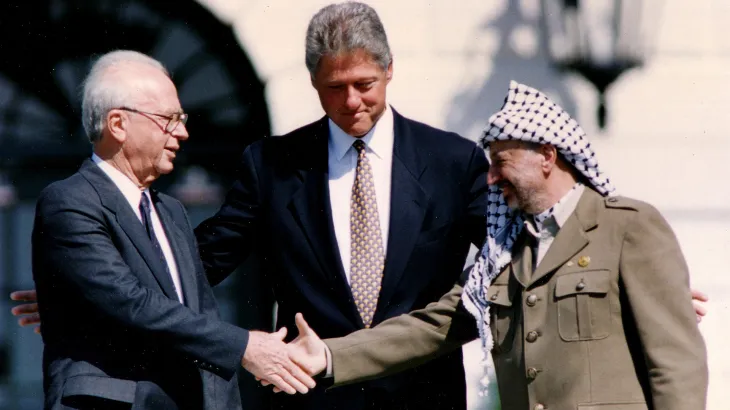“The Versailles settlement did not so much end the war as prolong it by other means.”
— Margaret MacMillan, Peacemakers: The Paris Peace Conference of 1919 and Its Attempt to End War (London: John Murray, 2001), p. 493.
On September 29 2025, Donald Trump stood beside Benjamin Netanyahu in the Oval Office, a map of Gaza spread out like a catechism, and declared history. “Very close” to ending the two-year war, the twenty-point document he read aloud was styled as a breakthrough. Netanyahu accepted immediately. Hamas, excluded from the drafting, was given the plan later by Egyptian and Qatari intermediaries, reduced to a respondent, not an author. The staging was instructive: Palestinians absent from the picture frame, absent from the script, absent from the future being spoken over them.
The exclusion of Palestinians from the drafting of the plan is not a procedural oversight but a political statement. By reducing them to respondents rather than participants, Trump and Netanyahu underscored the asymmetry at the heart of the plan. The Palestinian agency is often treated as an obstacle, rather than a necessity.
The response from Israel’s far-right ministers was swift and furious. Finance Minister Bezalel Smotrich (Religious Zionist Party) declared the plan “a resounding diplomatic failure,” a betrayal of the lessons of October 7. National Security Minister Itamar Ben-Gvir railed against Netanyahu’s supposed concessions, particularly his reported apology to Qatar for Israel’s attack on Hamas negotiators in Doha. For the settler movement, the plan forecloses the apocalyptic horizon they believed was within reach: the total conquest of Gaza and the mass displacement of Palestinians.
Yet their outrage is not matched by decisive action. Neither Ben-Gvir nor Smotrich is eager to collapse the coalition. They know they wield more influence inside government than outside it. Their strategy is sabotage from within: poisoning implementation, stirring public anger, and ensuring that any attempt to enforce the plan falters.
The deeper truth is that the Israeli far right has never been invested in peace as such. Its politics are driven by a messianic settler-colonial vision: to Judaize the land, erase Palestinian presence, and extend sovereignty “from the river to the sea.” For them, Gaza is not a territory to be pacified but to be claimed. Their fury at Trump’s plan is not because it gives too much to Palestinians—indeed, it provides almost nothing—but because it halts their crusade before its completion.
This dynamic reveals the structural trap of Israeli politics. War has become the glue holding the ruling coalition together. Peace—or even the semblance of peace—is politically riskier than war. Ending hostilities threatens to splinter the government; prolonging them keeps it intact. Netanyahu’s predicament is that he has cultivated a political order in which peace is viewed as treason and war is seen as a means of survival.
Netanyahu’s Gamble
This tension locks Netanyahu in a trap of his own making. To maintain his coalition, he must appease the far right. To maintain international credibility, he must at least appear to support Trump’s plan. Analysts, such as Alon Pinkas, a former Israeli diplomat, suggest that Trump’s insistence that Netanyahu publicly endorse the plan was meant to tie his hands. By forcing him to commit before the cameras in Washington, Trump reduced his room for evasion. Left to his own devices, Netanyahu might have tried to spin a different reality back home.
The personal stakes are no less pressing. Netanyahu faces corruption trials that could end his career—or his freedom. Prolonging the war has provided him cover: so long as Gaza burns, domestic politics can be deferred. Ending it risks exposing him to political retribution, both from the courts and from rivals within Likud and beyond. For Netanyahu, Trump’s plan is therefore not just a question of foreign policy but of survival.
Netanyahu’s instinct, honed over decades, is to delay. He is the master of the indefinite postponement, the cautious gesture that allows him to appear engaged while avoiding decisive action. As Pinkas noted, he may try to “kill it softly”: raise security concerns, claim to be studying the details, escalate rhetoric against Iran, and wait for Trump’s attention to move elsewhere. But delay has limits. The war’s human toll mounts, Israel’s society frays, and the international legitimacy crisis deepens.
However, an ironic development in the faction-ridden polity, the Palestine Authority chimed in support as other Arab and Muslim nations expressed a delicate confidence in Trump’s “ability to find a path to peace “in a calculated move.
Plan’s demands
The plan’s skeleton is familiar. Israel would withdraw in three stages, each contingent on Palestinian compliance. Hostages would be exchanged for prisoners, humanitarian aid would flow, and reconstruction would follow. Novelty was claimed in two devices: an International Stabilisation Force to police Gaza, and a Board of Peace chaired by Trump himself, assisted by Tony Blair and other notables. Yet these “innovations” are not innovations at all but citations from other conflicts—Balkan cantonment, Iraqi provisional councils, East Timor’s UN administration—recycled under new names. The calculus is unchanged: conditionality without reciprocity, governance without legitimacy, development without sovereignty.
Each clause is written as though Israel were bestowing gifts rather than conceding minimum obligations. Stage one promises aid corridors, the release of food and medicine, and the trickle of fuel. Yet as Edward Said wrote in The End of the Peace Process, the suspension of the siege is not generosity but duty, the baseline of law disguised as magnanimity. Survival is recast as privilege, with gratitude demanded in exchange for rights withheld. It is the old trick of occupation: reframe the occupier’s obligations as benevolence and the occupied’s survival as conditional.
Stage two proposes a transitional Palestinian authority, composed of technocrats and internationals, supervised by the Board of Peace. The fantasy of apolitical governance haunts every failed peace process. Christine Bell in On the Law of Peace reminds us that “apolitical” is itself a political posture, an alibi for external control. In Oslo, the Palestinian Authority was established as a body to police itself, tasked with administrative chores while sovereignty was suspended indefinitely. Gaza’s “technocratic” committee repeats this contradiction: rule without representation, management without mandate. Every municipal officer in Gaza has lived under Hamas, siege, or factional struggle. No society as politicised as ours can be governed by bureaucratic fiat. Apolitical Gaza is not Gaza at all, but erasure.
The Clause of Disarmament
The most startling demand lies in the timetable for disarmament. Hamas and other factions are ordered to dismantle tunnels, surrender weapons, and vanish as armed actors within seventy-two hours. Amnesty will be granted, but politics will be permanently denied. Comparative history makes the absurdity clear. John Darby’s study, “The Effects of Violence on Peace Processes,” demonstrates that disarmament is never a prelude but an epilogue: weapons are laid down only after recognition and reciprocity have been established. The IRA, for example, began decommissioning only after the Good Friday Agreement of 1998 secured prisoner releases, constitutional reform, and policing overhaul. Even then, as Louise Mallinder has shown, the process stretched from 2001 to 2005, supervised by Canadian General John de Chastelain’s Independent International Commission, with secrecy, ritual, and verification painstakingly balanced. It took four years—not seventy-two hours—and still factions splintered and arms disappeared into shadow.
The Balkans were no quicker. Bosnia’s militias were cantonised only under NATO’s Implementation Force, later SFOR, with tens of thousands of troops on the ground. As David Chandler argued in Bosnia: Faking Democracy after Dayton, disarmament was possible there only because an overwhelming external force and a legal mandate backed it. Kosovo’s KLA disarmed because NATO offered the incentive of transformation into the Kosovo Protection Corps. In East Timor, Indonesian militias were dismantled by the United Nations Transitional Administration, with blue helmets patrolling roads and cantonments. None of this resembled the Gaza ultimatum.
Southeast Asia repeats the pattern. Edward Aspinall’s Islam and Nation recounts how Aceh’s Free Movement agreed to decommission in 2005 only after Helsinki guaranteed autonomy, troop withdrawals, and political participation, with EU and ASEAN monitors enforcing credibility. In the Philippines, the Moro Islamic Liberation Front disarmed in phases over several decades, culminating in the 2014 Comprehensive Agreement on the Bangsamoro, which marked the end of 17 years of peace negotiations. The agreement was overseen by an Independent Decommissioning Body, composed of representatives from Turkey, Norway, and the Kingdom of Brunei, and verified each step. Everywhere, the sequence is the same: dignity first, arms later. Politics produces disarmament, not the other way around. According to reports, the Moro Islamic Liberation Front rebels in the southern Philippines have suspended the disarmament of its remaining 14,000 fighters after claiming that the government has not fully complied with commitments it made in the 2014 peace deal.
Trump’s plan refuses this lesson. It inverts the rhythm: disarmament first, recognition never. The seventy-two-hour ultimatum is designed to be refused, and refusal will then be narrated as proof of Palestinian intransigence. The plan is not meant to succeed. It is a script for blame. Versailles, not Good Friday.

The economic provisions are equally fantastical. Gaza is presented as an investment opportunity, “prime real estate” on the Mediterranean, awaiting the development of miracle cities. It is a development by brochure: Dubai transplanted into ruins. But Gaza is sealed, its airport in rubble, its seaport patrolled, every crossing throttled by Israeli permission. As Richard Caplan has observed of “internationally governed territories,” reconstruction without sovereignty is a mere façade: donor money circulates, projects are announced, but the fundamental structures of control remain. No investor will pour billions into a prison without gates. The Dubai imaginary collapses on contact with geography.
More corrosive still is the omission of representation. Who speaks for Gaza? The plan gestures vaguely toward a reformed Palestinian Authority. However, Netanyahu has long dismissed the PA as a non-partner, and Palestinians themselves often view it as a security subcontractor for Israel. Its police, accused of collusion in the West Bank, may be imported into Gaza under international training. But legitimacy cannot be imported. As Bell notes, peace agreements that bypass the consent of the governed often collapse into trusteeships —structures of management without sovereignty. What is proposed here is the administration of Palestinians, not their representation.
The politics behind the plan are as transparent as its clauses. For Netanyahu, acceptance offers optics without risk. He appears willing to end the war while ensuring its terms are impossible. If Hamas refuses, as it must, blame is shifted. The far-right elements of his coalition can rest assured that Palestinian concessions will never materialise, while Netanyahu accrues international capital by posturing as a peacemaker. With elections looming in 2026, the plan buys him time, perhaps even the opportunity to call early polls. The genius lies in its futility: a plan designed not for resolution but for performance.
Trump’s motives are no less theatrical. He presents himself as a dealmaker, the man who “solved” Gaza by unveiling a plan no one else could. The Board of Peace, with Blair at his side, becomes a stage for statesmanship. Blair’s presence is especially bitter. The man who once insisted on bringing Sinn Féin into the Belfast talks now lends his authority to a process that excludes Hamas altogether. In Northern Ireland, he learned that inclusivity was oxygen; in Gaza, he presides over erasure. Responsibility without power, legitimacy without sovereignty: the pose is familiar from Iraq.

The effect is a palimpsest of past failures. Oslo’s “interim” authority, Bosnia’s international police, East Timor’s UN administration, Aceh’s monitored autonomy—all are echoed here, stripped of their hard-won lessons and repackaged in technocratic prose. The stumbling blocks are the same: conditionality without reciprocity, governance without legitimacy, development without sovereignty. Novelty lies only in the compression of time and the audacity of erasure.
And yet the structure is cunning. By offering Palestinians impossibilities—disarm in three days, accept rule without representation, consent to development without sovereignty—the plan ensures its own failure. When failure occurs, it will be blamed on Hamas, not on the plan’s architecture. As Darby noted, peace processes can be undermined by “structural violence” built into their very design, ensuring one party carries the burden of rejection. The Gaza plan exemplifies that genre: a theatre of exoneration disguised as negotiation.
The lessons are already written in history. The IRA surrendered weapons only after politics shifted. Bosnia disarmed only under NATO’s shadow. Aceh’s rebels disarmed only after autonomy was granted. The Moro fighters in Mindanao disarmed only after decades of negotiation and recognition. Everywhere, disarmament followed dignity, reciprocity, and time. Trump’s plan, by contrast, demands capitulation first and dignity never.
Failure foretold
The deeper tragedy is not that it will fail but that it is meant to fail in a particular way: to absolve Israel, to flatter Washington, to script Palestinians as obstinate. It is not a peace plan but a performance of peace, rehearsed for cameras, staged upon ruins still smouldering. Versailles dressed as Good Friday, an ultimatum masquerading as a compromise.

History whispers that weapons are never surrendered until dignity is offered. Trump’s plan contradicts this: surrender first, dignity never. It is the continuation of war, written in the idiom of negotiation, lit by television lights, consumed by audiences far away. What is offered to Gaza is not reconciliation but erasure: technocrats managing rubble, Arab and Muslim soldiers policing quiet, Gulf investors laundering ruins into towers, Blair chairing the spectacle. The scaffolding of absence stands where the architecture of peace should be.
In Gaza, the plan’s twenty points are less a roadmap than a palimpsest of failure—old control structures dressed in new clothes, a collage of absent sovereignties. It is not peace; it is the continuation of war, staged upon ruins still smouldering.
Narendra Pachkhédé is a critic and writer who splits his time between Toronto,
London and Geneva.


